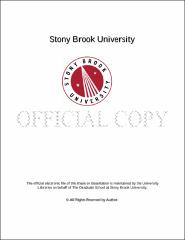| dc.identifier.uri | http://hdl.handle.net/11401/76221 | |
| dc.description.sponsorship | This work is sponsored by the Stony Brook University Graduate School in compliance with the requirements for completion of degree. | en_US |
| dc.format | Monograph | |
| dc.format.medium | Electronic Resource | en_US |
| dc.language.iso | en_US | |
| dc.publisher | The Graduate School, Stony Brook University: Stony Brook, NY. | |
| dc.type | Thesis | |
| dcterms.abstract | The anoxic Cariaco Basin located on the Venezuela continental shelf and the seasonally anoxic Forge River located on the south shore of Long Island are two quite different aquatic systems. However, they are both characterized by the pulsed intrusion of oxygen into sulfidic waters, where sulfur intermediates including sulfite (SO32-), thiosulfate (S2O32-), and zero-valent sulfur (So) are usually found. In this study, I investigated the distribution of sulfur intermediates and the relative importance of chemical and biological hydrogen sulfide oxidation to the sulfur intermediates distribution in these two systems. The sulfide oxidation rate, determined using Forge River water with an incubation in the dark at three temperatures (2, 25 and 40oC) and two initial ratios of H2S/O2 (0.7 and 2.8), was about 40- 300 times faster than the initial rate of chemical oxidation predicted from kinetic calculations, likely due to catalysis by trace metals. This observation was consistent with the lower activation energy of sulfide oxidation for two initial ratios of H2S/O2 which were 42±0.7 and 36±1.5 kJ mol-1 and were lower than the values of 66 ± 5 kJ mol-1 predicted for pure chemical oxidation of sulfide in air saturated seawater. In comparison with sulfide oxidation which could have been associated with chemoautotrophy, the chemical sulfide oxidation accounted for more than 90% of the total sulfide oxidation. In the deep and permanently anoxic Cariaco, the sulfur species are likely result of chemical H2S oxidation after oxygen intrusion. In a spiking experiment, chemoautotrophy was found to be either suppressed or undetectable in the presence of air and chloroform. However, under anoxic conditions, chemoautotrophy and the reaction of H2S with trace metals (either biotic or abiotic) both could be important for particulate elemental sulfur formation. In the Forge River, particulate elemental sulfur was most likely to be the result of chemical sulfide oxidation by a metal catalyst rather than that of biological processes. In both systems, zero-valent sulfur was the dominant sulfur intermediate product with higher concentrations found at a higher ratio of H2S to O2. | |
| dcterms.abstract | The anoxic Cariaco Basin located on the Venezuela continental shelf and the seasonally anoxic Forge River located on the south shore of Long Island are two quite different aquatic systems. However, they are both characterized by the pulsed intrusion of oxygen into sulfidic waters, where sulfur intermediates including sulfite (SO32-), thiosulfate (S2O32-), and zero-valent sulfur (So) are usually found. In this study, I investigated the distribution of sulfur intermediates and the relative importance of chemical and biological hydrogen sulfide oxidation to the sulfur intermediates distribution in these two systems. The sulfide oxidation rate, determined using Forge River water with an incubation in the dark at three temperatures (2, 25 and 40oC) and two initial ratios of H2S/O2 (0.7 and 2.8), was about 40- 300 times faster than the initial rate of chemical oxidation predicted from kinetic calculations, likely due to catalysis by trace metals. This observation was consistent with the lower activation energy of sulfide oxidation for two initial ratios of H2S/O2 which were 42±0.7 and 36±1.5 kJ mol-1 and were lower than the values of 66 ± 5 kJ mol-1 predicted for pure chemical oxidation of sulfide in air saturated seawater. In comparison with sulfide oxidation which could have been associated with chemoautotrophy, the chemical sulfide oxidation accounted for more than 90% of the total sulfide oxidation. In the deep and permanently anoxic Cariaco, the sulfur species are likely result of chemical H2S oxidation after oxygen intrusion. In a spiking experiment, chemoautotrophy was found to be either suppressed or undetectable in the presence of air and chloroform. However, under anoxic conditions, chemoautotrophy and the reaction of H2S with trace metals (either biotic or abiotic) both could be important for particulate elemental sulfur formation. In the Forge River, particulate elemental sulfur was most likely to be the result of chemical sulfide oxidation by a metal catalyst rather than that of biological processes. In both systems, zero-valent sulfur was the dominant sulfur intermediate product with higher concentrations found at a higher ratio of H2S to O2. | |
| dcterms.available | 2017-09-20T16:49:42Z | |
| dcterms.contributor | Taylor, Gordon | en_US |
| dcterms.contributor | Scranton, Mary I | en_US |
| dcterms.contributor | Zhu, Qingzhi. | en_US |
| dcterms.creator | Tong, Lan Thi | |
| dcterms.dateAccepted | 2017-09-20T16:49:42Z | |
| dcterms.dateSubmitted | 2017-09-20T16:49:42Z | |
| dcterms.description | Department of Marine and Atmospheric Science. | en_US |
| dcterms.extent | 64 pg. | en_US |
| dcterms.format | Monograph | |
| dcterms.format | Application/PDF | en_US |
| dcterms.identifier | http://hdl.handle.net/11401/76221 | |
| dcterms.issued | 2013-12-01 | |
| dcterms.language | en_US | |
| dcterms.provenance | Made available in DSpace on 2017-09-20T16:49:42Z (GMT). No. of bitstreams: 1
Tong_grad.sunysb_0771M_11370.pdf: 683771 bytes, checksum: 6ff281a369955be72057999c83009bf3 (MD5)
Previous issue date: 1 | en |
| dcterms.publisher | The Graduate School, Stony Brook University: Stony Brook, NY. | |
| dcterms.subject | Chemical oceanography | |
| dcterms.title | Comparisons of intermediate oxidation state sulfur compounds in the episodically | |
| dcterms.type | Thesis | |

